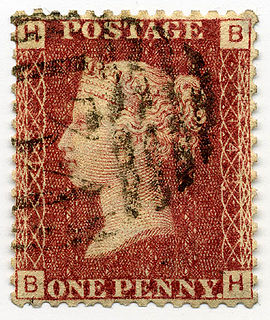
Philately is the study of postage stamps and postal history. It also refers to the collection, appreciation and research activities on stamps and other philatelic products. Philately involves more than just stamp collecting or the study of postage; it is possible to be a philatelist without owning any stamps. For instance, the stamps being studied may be very rare or reside only in museums.

A cancellation is a postal marking applied on a postage stamp or postal stationery to deface the stamp and to prevent its reuse. Cancellations come in a huge variety of designs, shapes, sizes, and colors. Modern cancellations commonly include the date and post office location where the stamps were mailed, in addition to lines or bars designed to cover the stamp itself. The term "postmark" refers specifically to the part that contains the date and posting location, but the term is often used interchangeably with "cancellation" as it may serve that purpose. The portion of a cancellation that is designed to deface the stamp and does not contain writing is also called the "obliteration" or killer. Some stamps are issued pre-cancelled with a printed or stamped cancellation and do not need to have a cancellation added. Cancellations can affect the value of stamps to collectors, positively or negatively. Cancellations of some countries have been extensively studied by philatelists, and many stamp collectors and postal history collectors collect cancellations in addition to the stamps themselves.
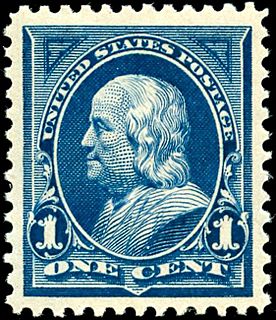
Postal service in the United States began with the delivery of stampless letters whose cost was borne by the receiving person, later encompassed pre-paid letters carried by private mail carriers and provisional post offices, and culminated in a system of universal prepayment that required all letters to bear nationally issued adhesive postage stamps.
This is a survey of the postage stamps and postal history of Hong Kong.
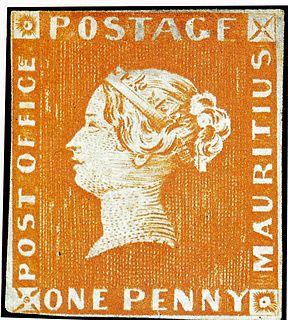
The Mauritius "Post Office" stamps were issued by the British Colony Mauritius in September 1847, in two denominations: an orange-red one penny (1d) and a deep blue two pence (2d). Their name comes from the wording on the stamps reading "Post Office", which was soon changed in the next issue to "Post Paid". They are among the rarest postage stamps in the world.

The Hawaiian Missionaries are the first postage stamps of the Kingdom of Hawaii, issued in 1851. They came to be known as the "Missionaries" because they were primarily found on the correspondence of missionaries working in the Hawaiian Islands. Only a handful of these stamps have survived to the present day, and so they are amongst the great rarities of philately.
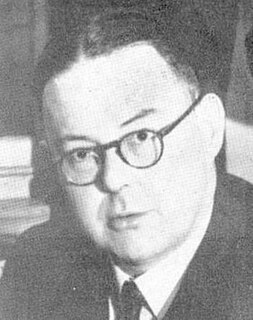
John Harry Robson Lowe was an English professional philatelist, stamp dealer and stamp auctioneer.

The postage stamps and postal history of Israel is a survey of the postage stamps issued by the state of Israel, and its postal history, since independence was proclaimed on May 14, 1948. The first postage stamps were issued two days later on May 16, 1948. Pre-1948 postal history is discussed in postage stamps and postal history of Palestine.

The postal history of Turkey and its predecessor state, the Ottoman Empire, dates to the 18th century when foreign countries maintained courier services through their consular offices in the Empire. Although delayed in the development of its own postal service, in 1863 the Ottoman Empire became the second independent country in Asia to issue adhesive postage stamps, and in 1875, it became a founding member of the General Postal Union, soon to become the Universal Postal Union. The Ottoman Empire became the Republic of Turkey in 1923, and in the following years, its postal service became more modernized and efficient and its postage stamps expertly designed and manufactured.

Lawrence Lewis "Larry" Shenfield was an advertising executive who was instrumental in promoting the development of radio broadcasting during its golden age of the 1920s and 1930s. Larry lined up sponsors to help further the popularity of such stars as Orson Welles and Dinah Shore. After his retirement, Larry developed a second career as a prominent philatelist internationally recognized in the field of postal history. His careful studies of the postage stamps and postal history of the Confederate States are relied upon by stamp collectors and experts in philately to the present day.

Plating refers to the reconstruction of a pane or "sheet" of postage stamps printed from a single plate by using individual stamps and overlapping strips and blocks of stamps. Likewise, if a sheet 10 or 20 postal cards is typeset, the variations of the letters or design elements may allow reconstruction or plating of the sheets based on these differences.
John Robert Boker Jr. was an American philatelist who amassed some of the most prestigious collections of 19th century stamps ever seen by stamp collectors. Before his death in 2003, the Collectors Club of New York declared him, in 1996, to be the "outstanding philatelist of the last half of the twentieth century."

The Roll of Distinguished Philatelists (RDP) is a philatelic award of international scale, created by the Philatelic Congress of Great Britain in 1921. The Roll consists of five pieces of parchment to which the signatories add their names.
Edward Spring Knapp, of New York City, was a philatelist known for his remarkable collections of postage stamps and postal history.
Dr. Leonard Kapiloff, of Maryland, was a philatelist recognized for his collecting of United States postage stamps issued prior to 1900.

The story of Japan's postal system with its postage stamps and related postal history goes back centuries. The country's first modern postal service got started in 1871, with mail professionally travelling between Kyoto and Tokyo as well as the latter city and Osaka. This took place in the midst of the rapid industrialization and social reorganization that the Meiji period symbolized in Japanese history. Given how the nation's railroad technology was in its infancy, Japan's growing postal system relied heavily on human-powered transport, including rickshaws, as well as horse-drawn methods of delivery. For example, while commemorating the 50th anniversary of Japan's postal service, the country's 1921 government released decorative postcards depicting intrepid horseback riders carrying the mail. This however was done to compare postal transport in past and present, as the other card showed modern transportation viz. rail and shipping. The railroad net from the north to the south, Aomori to Nagasaki, was completed in 1889. Prior to 1920s, local delivery was mainly by men- and horsepower, not principally different to Europe.
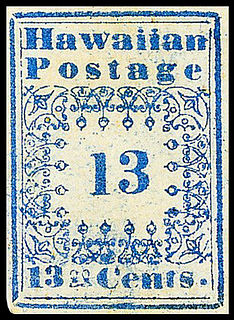
This is a survey of the postage stamps and postal history of Hawaii.
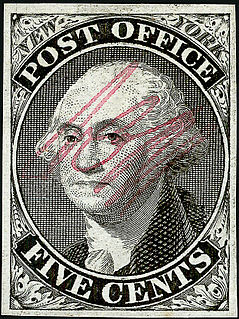
The New York Postmaster's Provisional is, as its designation implies, a postage stamp provided by the New York Post Office to facilitate the prepayment of mail at a time when the United States had not yet issued postage stamps for national use. Placed on sale on July 14, 1845, this was the nation's first provisional stamp to be issued by a local post office in response to the congressional postal reform act that had taken effect two weeks earlier. That law, passed on March 3, 1845, standardized nationwide mail rates, with the result that the use of stamps became a practical and reliable method of postal prepayment. Before standardization, the many different postal rates in different jurisdictions had made fees too unpredictable to prepay all letters with stamps as a matter of course, with the result that recipients of letters—rather than senders—generally paid the postage on them. Baltimore announced the issue of a provisional stamp one day after New York, on July 15, and New Haven soon followed. The New York issue has been cited as "the most elegantly executed and widely used of the group of provisionals issued by eleven different [U. S. post] offices between 1845 and 1847."

Steven Carl Walske is an American philatelist and philatelic writer. He was appointed to the Roll of Distinguished Philatelists in 2017.
















